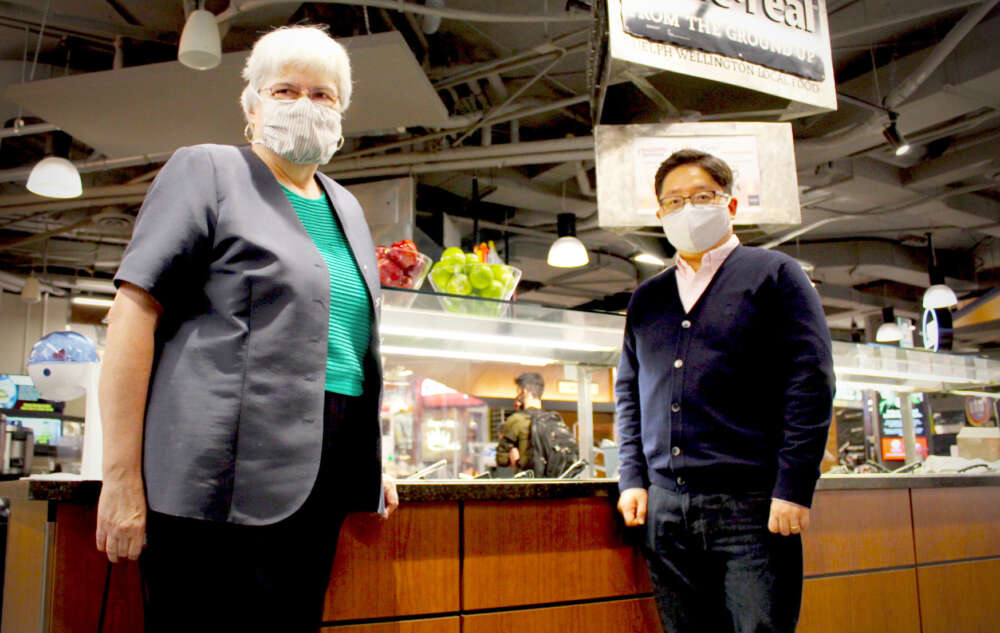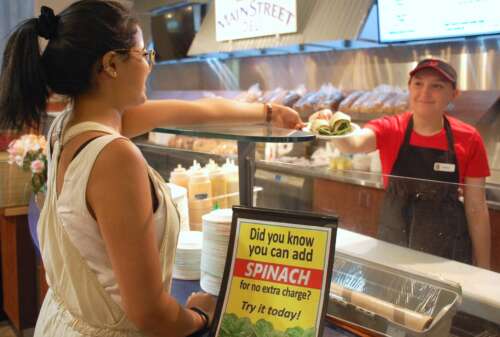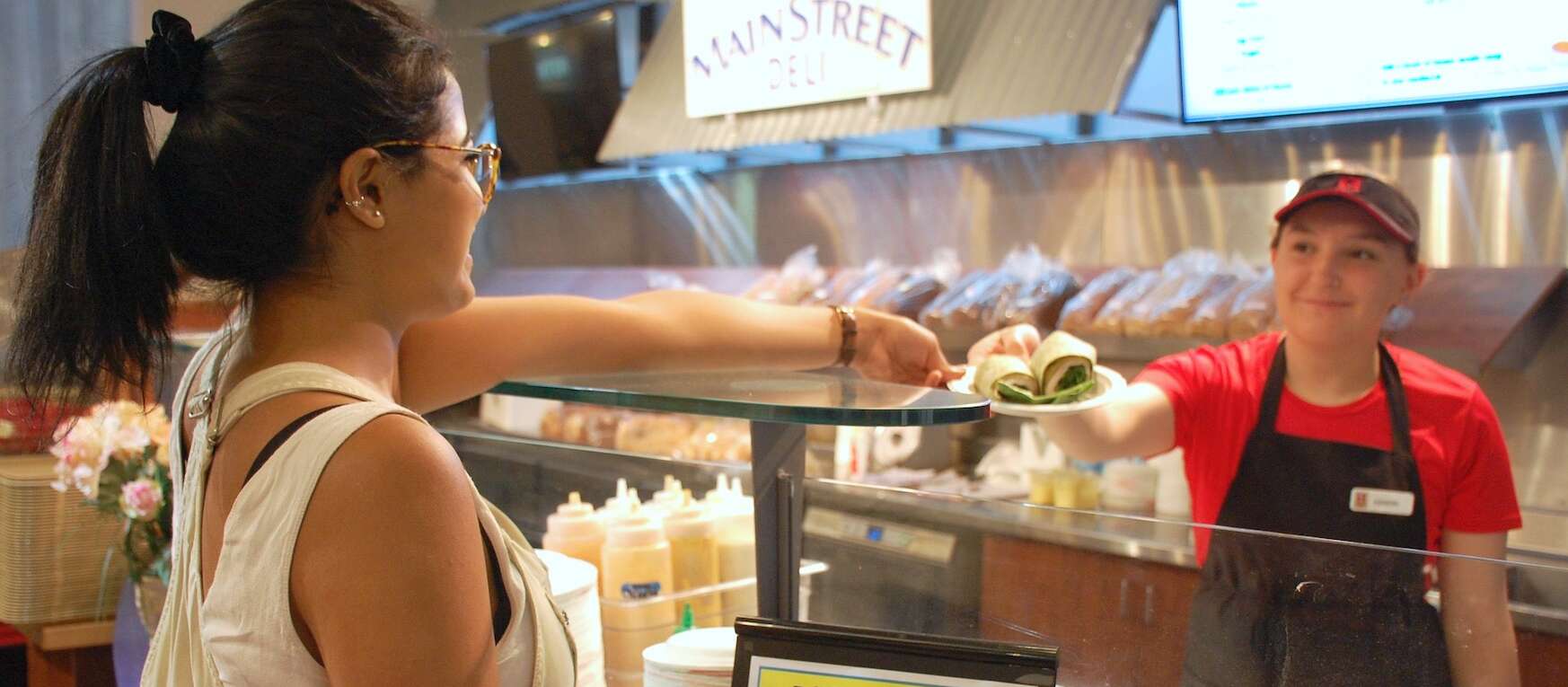“Eat your vegetables” is a refrain many university students hear so often that they tune it out. But what if they were quietly nudged to eat better while in campus food courts, cafeterias and other mass-eating contexts? Would they make better choices?
That’s what University of Guelph researchers have been testing, looking for new ways to subtly prompt students to choose more fruits and vegetables at campus dining facilities.
The technique is called “nudging” and involves modifying the environments where people make food decisions so it’s easier for them to pick healthy options. Nudging is intended to alter people’s behaviour without eliminating other options.
Marketing professor Dr. Sunghwan Yi with the Gordon S. Lang School of Business and Economics and applied nutrition researcher Dr. Paula Brauer in the College of Social and Applied Human Sciences have been studying nudging with funding from the Ontario Agri-Food Innovation Alliance.
“We know food choice decisions are made in a matter of seconds,” said Brauer, a professor in the Department of Family Relations and Applied Nutrition (FRAN). “And eye appeal, price, smell and the immediate choice environment all affect those decisions.”
Simply educating consumers about the benefits of healthy eating is often not enough when faced with this complex choice environment, said Yi.
“Emphasizing a food’s nutritional value in classrooms or mass media seldom prompts people to choose healthy food items. So, we wanted to know if nudging people toward healthy choices by modifying the environment where food choices are made would be more effective.”
Adding kale to smoothies, spinach to sandwiches

One technique they’ve tried is prompting customers who are about to make orders by placing signs next to cash registers that advise customers that kale or spinach could be added to smoothies.
“Prompting people toward a certain option at the time and place of choice counts, as nudging generally leads to greater behaviour change compared to communicating about benefits of choices.”
Another technique involved re-organizing a sandwich ordering station so that spinach was situated before iceberg lettuce as the first option for selecting items for a deli sandwich. Spinach was chosen 10 times as often in those cases.
A poster prompting customers to pick up fruit located near baskets of whole fruit increased sales by 10 to 15 per cent. Interestingly, adding more posters around the baskets had no additional effect.
“With these techniques, we don’t take away any choices. We just nudge them toward a healthier option,” said Yi.
The team has completed several papers on their findings. The first, published in 2019, surveyed students on which vegetables they would be most likely to eat at a university food service area and with what meal.
Other soon-to-be published research examined students’ acceptance of the idea of nudging.
“We as consumers are ‘nudged’ all the time, through ad displays, shelf arrangement, menu design and more,” said Yi. “But we needed to know what students thought about it in the context of campus food. If they found it manipulative or underhanded, then nudging techniques often loses power or may even backfire.”
Their latest study, published recently in Current Developments in Nutrition, evaluated food service managers’ attitudes to nudging: Would they be open to using nudging to convince students to eat more vegetables and fruit?
“Many universities use commercial food service companies, but there is a trend back to in-house chefs and hospitality services,” said Brauer. “Managers in these settings often have dual mandates to generate income as well as to promote student health, so they may be more receptive to trying these nudging approaches.”
‘What might work in one food service setting may not work in another’

Along with co-authors Kiran Bains and Natalie DeMarco, both former FRAN students, they surveyed food service managers from nine Canadian universities and one technical college. Edward Townsley, executive director of U of G’s Hospitality Services, provided advice and help with the collaboration.
Eight of the 10 institutions said they already used some form of fruit and vegetable nudging in marketing and health promotion.
Most initiatives were intended to reduce the effort needed to choose fruits and vegetables, including placing fruits and veggies closer to customers or at checkout counters, or moving healthier items to the beginning of a salad bar.
But they found managers were less likely to opt for measures that would be difficult or expensive to implement, such as those requiring structural changes. Managers were also hesitant to use methods such as sending text message reminders because of concerns for students’ privacy.
“This was important to investigate because many times, techniques that sound good in theory or that work in lab research don’t translate well to real-life settings,” said Brauer. “Managers had many perspectives. What might work in one food service setting may not work in another, so it is important to try out and adapt ideas to the local context.”
Added Yi: “This study provided some important new information that can inform further development of nudging interventions to increase the choice of fruit- and vegetable-rich meal options in university and worksite cafeterias operated by commercial food services.”
Contact:
Dr. Sunghwan Yi
syi@uoguelph.ca
Dr. Paula Brauer
pbrauer@uoguelph.ca
